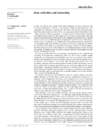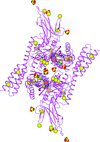issue contents
July 2013 issue
Data collection and processing
Proceedings of the CCP4 study weekend

Cover illustration: Speakers at the 2012 CCP4 Study Weekend and a selection of images from the articles in this special issue.
introduction
Open  access
access
 access
accessAn introduction to the proceedings of the CCP4 Study Weekend held at the University of Warwick on the 5–6 January 2012.
research papers
Open  access
access
 access
accessThe principles of one-dimensional FFT-based autoindexing of diffraction images are described together with practical issues that may arise. A procedure for indexing multiple lattices as implemented in iMosflm is presented.
Open  access
access
 access
accessThe new scaling program AIMLESS is described and tests of refinements at different resolutions are compared with analyses from the scaling step.
Open  access
access
 access
accessMaking the most of hard-won data in protein crystallography: to keep or not to keep, that is the question.
Open  access
access
 access
accessAn ultrasensitive Medipix2 detector allowed the collection of rotation electron-diffraction data from single three-dimensional protein nanocrystals for the first time. The data could be analysed using the standard X-ray crystallography programs MOSFLM and SCALA.
Open  access
access
 access
accessA processing pipeline for diffraction data acquired using the `serial crystallography' methodology with a free-electron laser source is described with reference to the crystallographic analysis suite CrystFEL and the pre-processing program Cheetah.
Open  access
access
 access
accessHardware and software solutions for MX data-collection strategies using the EMBL/ESRF miniaturized multi-axis goniometer head are presented.
Open  access
access
 access
accessA comparison of X-ray diffraction and radiographic techniques for the location and characterization of protein crystals is demonstrated on membrane protein crystals mounted within lipid cubic phase material.

Loading metrics information...
Download citation


Download citation



Loading metrics information...
Open  access
access
 access
accessThe basis for decision making in the program xia2 is described, alongside the framework to support these protocols. Where appropriate, applications of these protocols to interactive data processing are highlighted.
Open  access
access
 access
accessThe Computational Crystallography Toolbox (cctbx) is a flexible software platform that has been used to develop high-throughput crystal-screening tools for both synchrotron sources and X-ray free-electron lasers. Plans for data-processing and visualization applications are discussed, and the benefits and limitations of using graphics-processing units are evaluated.
Open  access
access
 access
accessRecent developments in X-ray crystallographic hardware related to structural biology research are presented and discussed.
Open  access
access
 access
accessThe key features of the functionality facilitating proprietary use of the ESRF's structural biology beamlines are described, as are the major advantages, in terms of beamline evolution, of the interaction of the ESRF with the pharmaceutical industry.
Open  access
access
 access
accessOptical trapping has successfully been applied to select and mount microcrystals for subsequent X-ray diffraction experiments.
Open  access
access
 access
accessThis article gives an overview of techniques and procedures for efficient data collection at synchrotron sources.
Open  access
access
 access
accessAnomalous diffraction signals from typical native macromolecules are very weak, frustrating their use in structure determination. Here, native SAD procedures are described for enhancing the signal to noise in anomalous diffraction by using multiple crystals are described. Five applications demonstrate that truly routine structure determination is possible without the need for heavy atoms.


 journal menu
journal menu




























